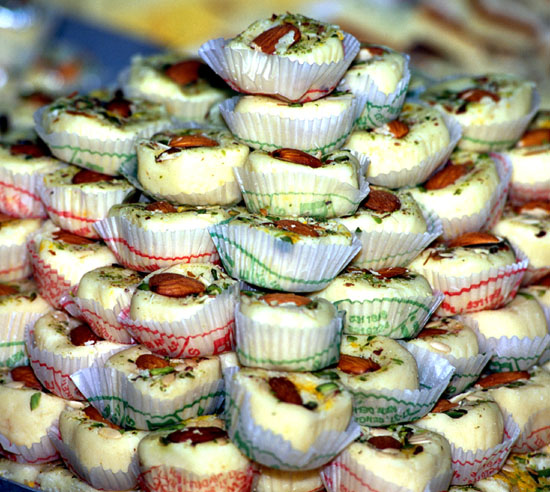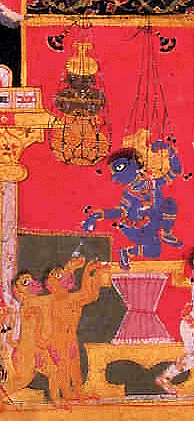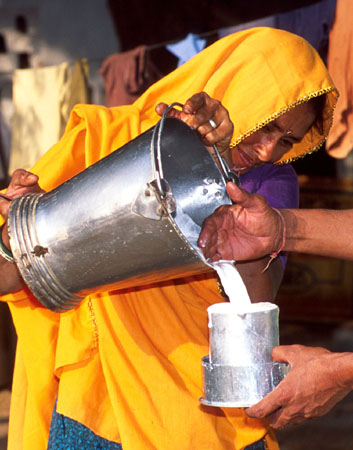

|


Milk Sweets
|
"Regarding what to do with the skim milk after the ghee has been produced. So far I have experience in India, after churning the butter the remnant is called gohle this gohle is called sour milk. Sour milk can be taken by the members of New Vrindaban along with food. In India in villages they have enough milk and sour milk is taken in place of water or in dahl with salt and pepper. So sour milk should be taken by the devotees and ghee used. Cheese is very valuable. Sometimes it is used by sweet meat shops in India and it is called khurcha. If you like you can make cheese but we require much quantity of ghee. My idea is that in India there is a great scarcity of ghee, but I don't think it is practical to send ghee from New Vrindaban to India. Anyway, go on developing New Vrindaban into an ideal community, and I shall be pleased to see the new additions when I come there."
Srila Prabhupada Letter to Kirtananda, 01-12-74, Boston
|
MILK
Raw Milk: Milk 'fresh from the cow'; the milk and cream separate, and cream rises to the top. Raw milk is essentially 'skim' milk once the cream is removed.
Homogenized: Milk that has been processed to keep the cream from separating from the milk. The homogenization blending process breaks up the milkfat in the cream so that it remains suspended throughout the milk rather than rising to the top.
Pasteurized: Milk that has been processed by a heating process with eliminates bacteria in milk. While the process isn't said to change nutrients, there is a reduction of the B and C itamin levels in pasteurized milk.

BUTTER
Sweet Cream Butter: A typical supermarket butter produced from pasteurized, homogenized milk, with a portion of the cream included.
Country Butter: Hand-churned butter made by first skimming the cream from the surface milk, allowing it to "set" in bowls, then churning with any one of many types of churners. Country butter often has a stronger taste than today's off-the-shelf butter, and more cream is used in the making. It takes about 20 pounds of fresh cow’s milk to make each pound of butter.
Makhan: In India, homemade butter is known as 'Makhan', which may be butter or soured cream rather than the sweet cream butter found in the west. Mahkan is cultured, with whole milk allowed to ferment overnight as in yoghurt or 'dahi' making. The heavier the milk, the lower the temperature of dahi. The temperature should be about 60° F for cow's milk makhan. The next morning it is churned for a steady 15 minutes or so, until the butter forms on the surface. Remove the butter as it forms and continue to churn. The remaining milk product, called 'chaach', or butter milk, is usually drunk with breakfast or lunch. Try making makhan by using 1 quart of heavy whipping cream with 2 tablespoons of plain yoghurt (live culture).
 "So the father conception of God, mother conception of God, is not bad. Just like in Bengal especially, they have got mother conception. Mother conception means the same thing, to exploit, take from mother, or father. But the Vaisnava conception is not to accept God as father or mother but as son. Son means to give. Father means to take from him, and son means to take from the father. So if you become father of God, then your business will be to give, not to take. That is Vaisnava conception. From the very beginning of the son's life, the mother is giving service to the son, the father is giving service. Therefore the service is there. Even Krsna is afraid of mother Yasoda. Why? Why mother Yasoda was trying to bind Krsna? Because He disrupted the process of service of mother Yasoda to Krsna. That is... Mother Yasoda tried that "You have broken the butter, and You have distributed to the monkeys, You rascal. Then how You will live? I kept the butter for You so that You will eat and You'll become fatty. And You have broken that, and You have distributed the butter to the monkeys, so You must be punished." So the aim is to serve Krsna, not that Yasoda is thinking, "My butter is spoiled by this child. Therefore He should be punished." He (she) is anxious to see that "Krsna may not starve for want of butter. He's child. He does not know. He has distributed the butter to the monkeys." But Krsna knows that "These monkeys are not ordinary monkeys." Those monkeys, they have taken birth in Vrndavana and come to Krsna. Do you think they're ordinary monkeys? They're devotees. They're devotees. They're playing as monkey for Krsna's satisfaction. These are the intricate meanings of understanding Krsna's lila."
Srila Prabhupada Lecture on Srimad-Bhagavatam, 10-12-74, Mayapur
|
GHEE
Ghee is one of the fundamental foodstuffs used in Vedic cooking. Known in the west as 'clarified butter', ghee is easy to make and a delight to cook with and consume. Ghee can be made by place one of several pounds of butter in an uncovered dish, left overnight in the oven at about 70 degrees F. In the morning, the end product will be three distinct layers of semi-solids and liquids. First, a crust will form containing all the butter impurities. Salted butter throws off more impurities than unsalted, and therefore forms a thicker crust. Beneath the crust is the second and widest layer, which is pure, golden liquid ghee. And on the bottom of the pan, a pool of white liquid whey collects. Each cook has a unique way of make and processing ghee, but I find it easiest to first skim off the impurities, which are set aside for later use (they're wonderful cooked into other sabjis). Next, ladel off as much of the golden ghee as possible without mixing in any of the whey. Finally, I put the pan in the refrigerator for an hour or so, which causes the remaining ghee to solidify into a solid yellow block. Beneath the ghee, the whey will still be in a liquid state. Tip the pan just enough to slide the solid block of ghee aside so you can pour off the whey into a separate container. Any whey that remains on the bottom of the block of ghee can be easily patted off with paper toweling. When you're ready to cook, just heat the ghee and it returns to liquid oil. Like the impurities, keep the whey for later use as it's wonderful cooked into vegetable dishes, etc.

CHEESE
Paneer and Chenna: Paneer is similar to fresh cheeses like cottage cheese, although paneer is coagulated with head and acid, whereas cottage cheese is usually made with a rennet/acid mix. When making paneer, the milk is boiled before acid is added so a higher yield paneer results, having better protein quality. The higher the fat content of the milk and cream, the richer and creamier the paneer will be. Paneer texture and moisture levels can be modified by temperature and cream content as well. Paneer is a great source of animal protein, and an wonderful element to the vegetarian diet.
To make paneer, slowly bring milk to a boil in a heavy bottom pan to prevent scorching. When it begins to boil, add yoghurt, lemon juice or other acid to begin the curdling process. Let it boil for another minute or two, then turn off the heat. Stir very gently so the curd isn't broken apart again in the milk. When the whey (the remaining liquids) begin to clear to a light yellowish color, drain through cheese cloth. Add weight to the top of the drained bundle of cheese cloth to expel any remaining whey, and to get the desired consistency. Chenna is made in exactly the same way as paneer, and is simply a moister, looser version.
A basic paneer recipe is about 2 quarts or milk to 1 cup of yoghurt, or 1 gallon of milk to 1/4 cup of lemon juice concentrate. It takes about 6.5 pounds of milk to yield 1 pound of paneer.
Cured Cheese: Cheese making is done in nearly all countries around the world today, and the art of making cheese is as different as the makers. Basically, cheese making requires a starter culture, than can be gotten from letting two cups of fresh milk sit at room temperature for 24 hours or until it curdles to a yoghurt consistency. Next, the culture is mixed into 2 gallons of warm milk (about 86 degrees F), and is left to sit overnight at a temperature of 50 to 60 degrees F. This will cause the milk to form lactic acid. Next, a milk-coagulating enzyme must be added, and various types of non-animal rennet can be used. When added to the milk, the enzymes cause curd to form. The mixture is warmed so the curd solids will separate from the whey, usually by draining through cheese cloth. The curds are then salted or otherwise flavored, and hung for a number of hours. Next, the firmed up curd is shaped and pressed with weight, and left to dry out over a few days until a rind starts to form on the outside. Finally, the entire wheel of cheese is sealed in wax and left to cure at 40 to 60 degrees for anywhere from several weeks to months. Curing time and conditions, along with flavor additives, determine what type of cheese will result.

YOGHURT
Dahi: Technically, Dahi (homemade yoghurt) is fermented milk in which some of the lactose has been converted to lactic acid by the action of bacteria. Dahi is a highly valued foodstuff because it has the same nutritional value as milk, but 90% of yoghurt is digested with one hour, whereas only 30% of milk digests in the same period. This is the case because the bacteria in Dahi produce enzymes that continue to work favorably in the digestive tract. Dahi that has been pasteurized or processed at high temperatures causes the bacteria to be inactive, and these benefits are then lost. to make Dahi, begin with 1 quart of regular Milk, to which you may add 2 Tablespoons of starting culture. To begin, you can use a natural regular yoghurt as starter, then just reserve some of the produced yoghurt to use as a starter in future. See the "Recipes" section for details on making your own Dahi.

|
Madhudvisa: "These are preparations which is prepared from Australian milk.
Prabhupada: Let him take. Yes.
Guest (2): Oh, thank you.
Madhudvisa: Give a napkin. It's a sweet preparation called gulab jamin. It is all prepared just from milk which has been made into curd, and then the curd has been fried in ghee, cooking ghee, and then after it has been fried, it has been soaked in sweet water and it is very palatable. It's called a gulab jamin. It is a very famous delicacy of Indian cooking. It requires great skill and art to prepare these. And as our spiritual master said, there is actually hundreds and hundreds of food which can be prepared from this, like the cheese you have there. Even cooking cheese and spicing it with asafoetida and ginger, meat taste can be simulated very, very nicely.
Prabhupada: This cheese as it is you take, it is as beneficial as meat.
Madhudvisa: Protein.
Guest (2): Yes, yes. Similar protein.
Prabhupada: So why the animal should be killed? Take milk.
Guest (2): What is sweet water? You mean just sugar...
Madhudvisa: Syrup.
Guest (2): Now is this made here or in India?
Madhudvisa: Yes, we make it ourselves. Our spiritual master taught us how to make it. (laughter) An ancient science.
Prabhupada: No, no, I am teaching them, "Eat nicely, live nicely, and be prepared for your next life, for going back to home, back to Godhead." You can take it. It is very nice.
Guest (2): You mean to eat it now?
Prabhupada: Yes.
Guest (2): I would sooner take it home and eat it with my wife.
Prabhupada: No, no, you take, you take it. You just...
Madhudvisa: I can give you another.
Prabhupada: Yes. If you like we shall give you more.
Satsvarupa: It's very sweet. Watch it, it's very drippy though.
Guest (2): Yes, it looks like it.
Prabhupada: And if you send us cheese like this we can send you many things. (laughter)
Dr. Muncing: It's very nice, but I must save some for my family.
Dr. Harrap: I'd probably be irreligious if I said that it was soaked in rum, but... (laughter)
Dr. Muncing: It's very good.
Prabhupada: Shall I give you more?
Dr. Harrap: No, that's very nice, thank you. It'll ruin my dinner. Can I take the rest home?
Madhudvisa: Oh yes.
Dr. Muncing: Well, this has been most interesting.
Dr. Harrap: Oh, yes. Public relations for dairy research.
Madhudvisa: One thing that we would like to mention, as our spiritual master says, there is a definite, according to the Vedic scripture, there is a definite link between consumption of milk and development of fine brain tissues. And if your department of knowledge has some research in that area, we think it would be a great service to mankind if they can be informed how they can develop fine brain tissues. Fine brain tissues which are needed for coping with the problems of this day and age. Not that simply if I disagree with you we'll just fight. There has to be fine brain tissues in order to say, "Let us sit down and talk about this together." And we say, not we, but according to the scripture, there is a definite link between the consumption of milk products, not just milk, but cheese and all different milk products, the consumption of milk products and development of the necessary intellect. This is why, as our spiritual master said, the highly intelligent people of India have lived predominantly, not just drinking milk, but everything they ate was cooked in milk products. The vegetables, rice, even if rice was boiled, milk was put on, ghee was put on the rice. So that is like an unavoidable essential in their diet, not simply from the palatable standpoint, but actually from the relationship between the physical and the metaphysical progress.
Prabhupada: And thousands of tons of ghee, clarified butter, was offered in the yajna. The smoke created a kind of cloud which is very good for cultivation."
Srila Prabhupada Room Conversation, 07-02-74, Melbourne
|


|
|